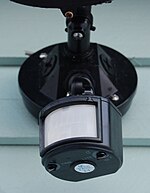Motion detector

A motion detector is a device that detects moving objects, particularly people. A motion detector is often integrated as a component of a system that automatically performs a task or alerts a user of motion in an area. Motion detectors form a vital component of security, automated lighting control, home control, energy efficiency, and other useful systems.
Overview

An electronic motion detector contains a motion sensor that transforms the detection of motion into an electric signal. This can be achieved by measuring optical changes in the field of view. Most inexpensive motion detectors can detect up to 15 feet (5 meters). Specialized systems are more expensive but have much longer ranges. Tomographic motion detection systems can cover much larger areas because the signals penetrate walls and obstructions.
A motion detector may be connected to a burglar alarm that is used to alert the home owner or security service after it detects motion. Such a detector may also trigger a red light camera. Motion detectors have found great application in domestic and commercial applications. Some of these applications include motion-activated outdoor lighting systems, motion sensor street lamps and motion sensor lanterns.
Sensors

There are four types of sensors used in motion sensor spectrum:
- Passive infrared (PIR)
- Passive infrared sensors detect a person's body heat as it changes against the background of the room. No energy is emitted from the sensor, thus the name "passive infrared" (PIR).
- Ultrasonic
- Sends out pulses of ultrasonic waves (acoustic sound waves above the frequency that a human can hear) and measures the reflection off a moving object. Motion causes the frequency of the reflected wave to change (Doppler effect).
- Microwave
- A microwave sensor sends out electromagnetic pulses and measures the changes in frequency (Doppler) due to reflection off a moving object.
- Tomographic motion detector
- Tomographic motion detection systems sense disturbances to radio waves as they pass from node to node of a mesh network. They have the ability to detect over complete areas because they can sense through walls and obstructions.
Dual-technology motion detectors
Many modern motion detectors use combinations of different technologies. While combining multiple sensing technologies into one detector can help reduce false triggering, it does so at the expense of reduced detection probabilities and increased vulnerability. For example, many dual-tech sensors combine both a PIR sensor and a microwave sensor into one unit. In order for motion to be detected, both sensors must trip together. This lowers the probability of a false alarm since heat and light changes may trip the PIR but not the microwave, or trees may trigger the microwave but not the PIR. If an intruder is able to fool the PIR or microwave, however, the sensor will not detect. Dual-tech sensors are only as strong as their weakest link.
Often, PIR technology will be paired with another model to maximize accuracy and reduce energy usage. PIR draws less energy than microwave detection, and so many sensors are calibrated so that when the PIR sensor is tripped, it activates a microwave sensor. If the latter also picks up an intruder, then the alarm is sounded.
See also
- Heat detector
- Motion controller for video game consoles
- Motion detection
- Pickup (music technology)
- Remote camera
- Smoke detector
References
External links
- How to build your own motion detector
- Video Motion Detectors
- Passive infrared and microwave detectors
- Presence and Absence detection explained
- Comparison of various motion detection technologies
